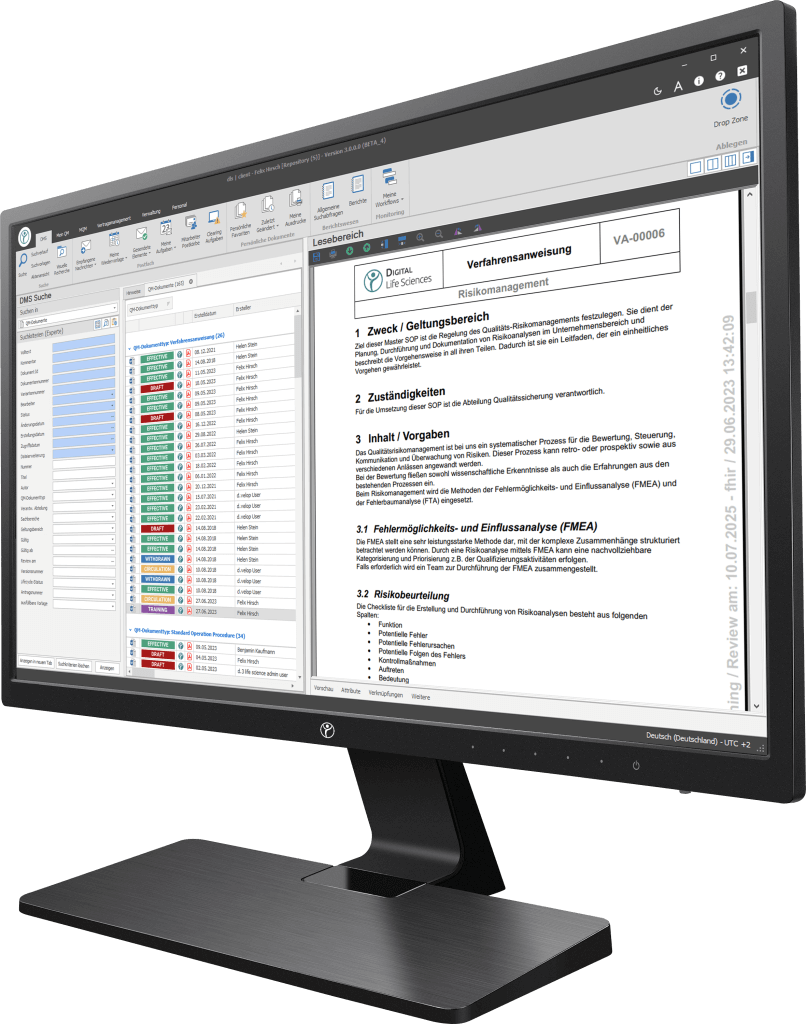Definition of the term (“What is ISO 13485:2016?”)
ISO 13485:2016 is an internationally recognized standard developed specifically for the medical device industry. It sets out the requirements for a quality management system (QMS) that ensures the consistent design, development, production, installation and delivery of medical devices that are safe and effective for their intended purpose.
What are the main features of ISO 13485:2016?
- Customer orientation: ISO 13485:2016 focuses on customer satisfaction and ensures that medical device manufacturers prioritize the needs and expectations of their customers.
- Risk management: Risk management is an integral part of ISO 13485:2016. Manufacturers must identify and mitigate risks associated with their medical devices during the product lifecycle.
- Regulatory Compliance: Compliance with relevant regulatory requirements is a key aspect of ISO 13485:2016. This ensures that medical devices comply with legal and safety standards.
- Continuous improvement: The standard promotes a culture of continuous improvement and encourages organizations to continuously improve their processes and products.
Your path to digitization — Discover our software
Our digitization solutions primarily address document-based processes in manufacturing, production and quality management. The basis of the dls | eQMS is a holistic ECM/DMS system. The ECM/DMS system can be connected to your existing ERP system (e.g. SAP) and thus map almost all document-based processes in the company.

What are the benefits of the ISO 13485:2016 certification?
- Improved product quality: By complying with ISO 13485:2016, medical device manufacturers can improve the overall quality of their products, leading to increased patient safety.
- Access to the global market: The ISO 13485:2016 certification is recognized worldwide and facilitates market access for medical device manufacturers in various regions.
- Regulatory Compliance: Meeting the requirements of ISO 13485:2016 brings an organization into compliance with regulatory standards and reduces the risk of legal issues.
How can ISO 13485:2016 be implemented?
- Launch: To successfully implement ISO 13485:2016 organizations should start by understanding the standard’s requirements and performing a gap analysis.
- Documentation: Documenting processes and procedures is a critical step toward compliance with ISO 13485:2016. This helps to ensure transparency and traceability.
- Training and awareness-raising: Employees must be trained and informed about the quality management system to ensure effective implementation.
Conclusion
ISO 13485:2016 is an important standard for the medical device industry that emphasizes quality, safety and regulatory compliance. By adopting and implementing this standard, organizations can improve the quality of their products, gain access to global markets and ensure patient safety.
Start your digital transformation with our powerful, modular software solutions
Frequently Asked Questions (FAQs)
What is ISO 13485:2016?
ISO 13485:2016 is an international standard for the medical device industry that specifies requirements for a quality management system.
How can ISO 13485:2016 benefit my organization?
ISO 13485:2016 certification can improve product quality, provide access to the global market and ensure regulatory compliance.
What is the role of risk management in ISO 13485:2016?
Risk management is an integral part of ISO 13485:2016 and requires organizations to identify and mitigate risks associated with their medical devices.
How do I start with the implementation of ISO 13485:2016?
Begin by understanding the requirements of the standard, performing a gap analysis, and documenting your processes.
Is ISO 13485:2016 recognized worldwide?
Yes, ISO 13485:2016 is recognized globally and facilitates market access for medical device manufacturers.
What is the most recent ISO 13485 standard?
The latest edition of the standard was published in 2016, which gave the ISO standard its designation ISO 13485:2016.
What are the changes in ISO 13485:2016 from its predecessors?
The fundamental changes in the 2016 version compared to its predecessors are in the product safety of medical IT. In this context, the standard prescribes security precautions for the storage of patient-related data and thus also addresses aspects of data protection. It falls under the section of legislation and is used to comply with the European Directive on Medical Devices, 93/42/EEC.
Why is chapter 4 of ISO 13485:2016 so important?
Chapter 4 states that the organization must have a quality management system and maintain its effectiveness. A risk-based approach is always applied to control the quality of the processes. If software is used as section of quality management, it must be validated before implementation. The activities associated with validation and revalidation must be proportionate to the risk associated with the use of the software. The activities have to be documented accordingly and the quality management requires to control the prepared documents as well.
